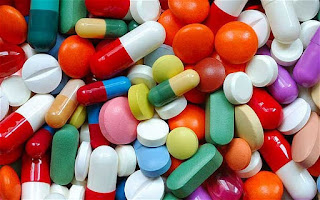Digoxin
Trade name: Lanoxicaps, Lanoxin, Novo-Digoxin
(CAN)
Drug classes:
§ Cardiac glycoside
§ Cardiotonic agent
Pregnancy: (Category C)
Therapeutic
actions
Increases intracellular calcium and allows
more calcium to enter the myocardial cell during depolarization via a
sodium---potassium pump mechanism; this increases force of contraction
(positive inotropic effect), increases renal perfusion (seen as diuretic effect
in patients with CHF), decreases heart rate (negative chronotropic effect), and
decreases AV node conduction velocity.
Indications
• CHF
• Atrial fibrillation
• Atrial flutter
• Paroxysmal atrial tachycardia
Dose
by mouth,
rapid digitalization, 1–1.5 mg in divided doses over 24 hours; less urgent
digitalization, 250–500 micrograms daily (higher dose may be divided), Maintenance, 62.5–500 micrograms daily (higher dose
may be divided) according to renal function and, in atrial fibrillation, on
heart-rate response; usual range, 125–250 micrograms daily (lower dose may be
appropriate in elderly)
Emergency loading
dose by intravenous infusion, 0.75–1 mg over at least 2 hours then maintenance dose by mouth on the following day Contraindications:
• Contraindications: allergy to digitalis preparations,
ventricular tachycardia, ventricular fibrillation, heart block, sick sinus
syndrome, IHSS, acute MI, renal insufficiency and electrolyte abnormalities
(decreased K+, decreased Mg++, increased Ca++).
• Use cautiously with pregnancy and lactation.
Side effects:
• CNS: Headache, weakness, drowsiness, visual disturbances
• GI: GI upset, anorexia
• CV: Arrhythmias
Nursing
Considerations
• Monitor apical pulse for 1 min before administering; hold dose
if pulse <60 in adult or <90 in infant, retake pulse in 1 h. If adult
pulse remains <60 or infant <90, hold drug and notify prescriber. Note
any change from baseline rhythm or rate.
• Check dosage and preparation carefully.
• Avoid IM injections, which may be very painful.
• Follow diluting instructions carefully, and use diluted solution
promptly.
• Avoid giving with meals; this will delay absorption.
• Have emergency equipment ready; have K+ salts, lidocaine,
phenytoin, atropine, and cardiac monitor on standby in case toxicity develops.
• Monitor for therapeutic drug levels: 0.5---2 ng/mL.



